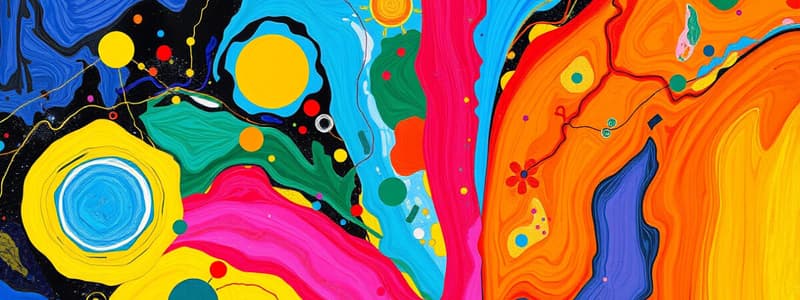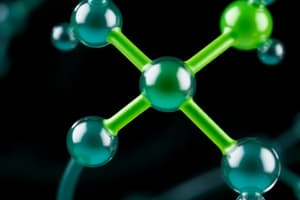Podcast
Questions and Answers
What does it mean when an object has mass?
What does it mean when an object has mass?
- It is made up of atoms. (correct)
- It has a shape that changes.
- It takes up no space.
- It is a gas.
Which of the following best describes the properties of liquids?
Which of the following best describes the properties of liquids?
- They have a definite shape but no mass.
- They have a definite mass but take the shape of their containers. (correct)
- They have no mass and no volume.
- They have a definite shape and volume.
What characteristic distinguishes gases from solids?
What characteristic distinguishes gases from solids?
- Gases are in constant motion and can spread out. (correct)
- Gases have a definite mass.
- Gases have a fixed volume.
- Gases can be observed in a solid state.
How do we figure out the state of matter an object fits into?
How do we figure out the state of matter an object fits into?
Why do liquids change shape?
Why do liquids change shape?
What allows gases to move around freely?
What allows gases to move around freely?
Which gas is NOT mentioned as part of the earth's atmosphere?
Which gas is NOT mentioned as part of the earth's atmosphere?
What happens to water when it is heated?
What happens to water when it is heated?
What are the three states of matter as illustrated with water?
What are the three states of matter as illustrated with water?
How can you observe the change of states in water?
How can you observe the change of states in water?
Flashcards
Mass of an object
Mass of an object
A measure of the amount of matter in an object.
Liquid properties
Liquid properties
Liquids have a definite mass, but take the shape of their container.
Gas vs Solid
Gas vs Solid
Gases move freely and spread out, while solids have a definite shape.
States of Matter
States of Matter
Signup and view all the flashcards
Liquid shape change
Liquid shape change
Signup and view all the flashcards
Gas movement
Gas movement
Signup and view all the flashcards
Water heating
Water heating
Signup and view all the flashcards
States of Water
States of Water
Signup and view all the flashcards
Observing state changes
Observing state changes
Signup and view all the flashcards
Identifying states of matter
Identifying states of matter
Signup and view all the flashcards
Study Notes
States of Matter
- Matter is anything that occupies space and has mass.
- There are three primary states of matter: solid, liquid, and gas.
Properties of Matter
- Properties used to identify the state of matter include:
- Shape: Relates to the form an object takes.
- Mass: The amount of matter in an object.
- Volume: The space occupied by the matter.
Solids
- Solids have a definite shape, mass, and volume.
- Atoms in solids are tightly packed, giving them a fixed structure.
- Example of solids includes trees, furniture (chairs), and ice.
Liquids
- Liquids have a definite mass and volume but do not have a fixed shape.
- The atoms in liquids are close together but can move around, allowing liquids to flow and take the shape of their container.
- Common examples include milk and juice.
Gases
- Gases lack a definite shape and volume, taking both the shape and volume of their containers.
- Atoms in gases are much farther apart, allowing them to move freely and spread out.
- Everyday examples include the air we breathe, which contains gases like oxygen and helium.
Water's Changing States
- Water can exist in all three states: solid (ice), liquid (water), and gas (water vapor).
- The transition from ice to water is called melting, while water vapor is produced through evaporation.
Observations in Everyday Life
- Matter can be identified in various forms around us; for example, solid, liquid, and gas can often be found in a typical household setting.
- A simple experiment can show the states of matter by observing the melting of ice to water and then evaporation to water vapor.
Studying That Suits You
Use AI to generate personalized quizzes and flashcards to suit your learning preferences.




